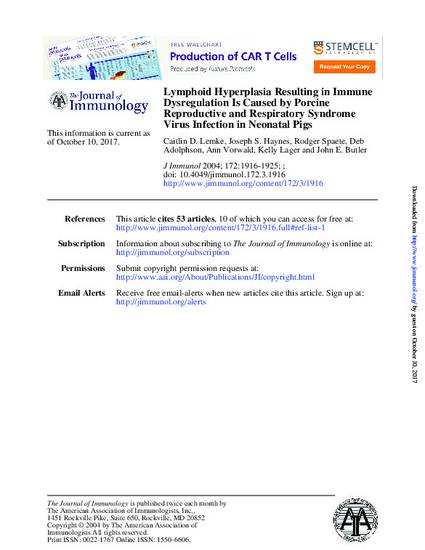
Article
Lymphoid Hyperplasia Resulting in Immune Dysregulation Is Caused by Porcine Reproductive and Respiratory Syndrome Virus Infection in Neonatal Pigs
The Journal of Immunology
Document Type
Article
Disciplines
Publication Version
Published Version
Publication Date
2-1-2004
DOI
10.4049/jimmunol.172.3.1916
Abstract
Amid growing evidence that numerous viral infections can produce immunopathology, including nonspecific polyclonal lymphocyte activation, the need to test the direct impact of an infecting virus on the immune system of the host is crucial. This can best be tested in the isolator piglet model in which maternal and other extrinsic influences can be excluded. Therefore, neonatal isolator piglets were colonized with a benign Escherichia coli, or kept germfree, and then inoculated with wild-type porcine reproductive and respiratory syndrome virus (PRRSV) or sham medium. Two weeks after inoculation, serum IgM, IgG, and IgA levels were 30- to 50-, 20- to 80-, and 10- to 20-fold higher, respectively, in animals receiving virus vs sham controls, although <1% was virus specific. PRRSV-infected piglets also had bronchial tree-associated lymph nodes and submandibular lymph nodes that were 5–10 times larger than colonized, sham-inoculated animals. Size-exclusion fast performance liquid chromatography revealed that PRRSV-infected sera contained high-molecular-mass fractions that contained IgG, suggesting the presence of immune complexes. Lesions, inflammatory cell infiltration, glomerular deposits of IgG, IgM, and IgA, and Abs of all three isotypes to basement membrane and vascular endothelium were observed in the kidneys of PRRSV-infected piglets. Furthermore, autoantibodies specific for Golgi Ags and dsDNA could be detected 3–4 wk after viral inoculation. These data demonstrate that PRRSV induces B cell hyperplasia in isolator piglets that leads to immunologic injury and suggests that the isolator piglet model could serve as a useful model to determine the mechanisms of virus-induced immunopathology in this species.
Rights
Works produced by employees of the U.S. Government as part of their official duties are not copyrighted within the U.S. The content of this document is not copyrighted.
Language
en
File Format
application/pdf
Citation Information
Caitlin D. Lemke, Joseph S. Haynes, Rodger Spaete, Deb Adophson, et al.. "Lymphoid Hyperplasia Resulting in Immune Dysregulation Is Caused by Porcine Reproductive and Respiratory Syndrome Virus Infection in Neonatal Pigs" The Journal of Immunology Vol. 172 Iss. 3 (2004) p. 1916 - 1925 Available at: http://works.bepress.com/joseph-haynes/12/

This article is published as Lemke, Caitlin D., Joseph S. Haynes, Rodger Spaete, Deb Adolphson, Ann Vorwald, Kelly Lager, and John E. Butler. "Lymphoid hyperplasia resulting in immune dysregulation is caused by porcine reproductive and respiratory syndrome virus infection in neonatal pigs." The Journal of Immunology 172, no. 3 (2004): 1916-1925. doi: 10.4049/jimmunol.172.3.1916. Posted with permission.